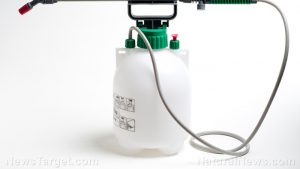
Terbufos — toxicity, side effects, diseases and environmental impacts
Thursday, November 16, 2017 by Zoey Sky
http://www.naturalpedia.com/terbufos-toxicity-side-effects-diseases-and-environmental-impacts.html

Terbufos is a highly toxic organophosphate pesticide, and products containing the chemical are labeled dangerous. Terbufos’ trade names include AC 92100, Aragran, Contraven, Counter, and Plydox. Used as an organophosphate insecticide, terbufos is a liquid that has a clear to slightly brown color when at room temperature.
Terbufos is formulated as granules and it is applied during planting or directly on the seed. The chemical acts as an insecticide and nematicide. It was previously used to control wireworms, seedcorn maggots, white grubs, corn rootworm larvae, and other pests on plants such as corn, grain, sorghum, sugar beets, and bananas.

List of known side effects
Terbufos may be fatal if swallowed, inhaled, or absorbed through the skin. Repeated inhalation or skin contact with this toxic chemical may progressively increase susceptibility to poisoning.
Terbufos is flammable up to the second degree. Since this chemical is a liquid organophosphorus pesticide, fire may produce irritating or poisonous gases. Terbufos is combustible and is a moderate fire risk. The chemical hydrolyzes under alkaline conditions.
Terbufos decomposes on heating and on burning, which produces highly flammable and toxic gases. The chemical reacts with oxidizing substances, and this produces toxic fumes, including phosphorous oxides.
Terbufos is a cholinesterase inhibitor. Acute exposure to terbufos can cause the following symptoms: pinpoint pupils, blurred vision, headache, dizziness, muscle spasms, and profound weakness. Vomiting, diarrhea, abdominal pain, seizures, and coma may also occur.
Body systems affected by terbufos
Terbufos inhibits cholinesterase, and this toxic chemical can affect the eyes, lungs, skin, and central nervous system, depending on the route of exposure and the concentration.
The heart rate may decrease after oral exposure to terbufos or increase after dermal exposure. Exposure to terbufos can also cause chest pain. Hypotension (low blood pressure) may be noted, although hypertension (high blood pressure) is another common side-effect of exposure to the chemical.
Respiratory symptoms of exposure to terbufos include dyspnea (shortness of breath), respiratory depression, and respiratory paralysis. Psychosis may occur. Acute exposure to terbufos may require decontamination and life support for the victims.
Items that can contain terbufos
Terbufos is used as a pesticide, and it is applied as a granular formulation (15 and 20% active ingredient). The trade names of this toxic chemical include: Counter, Counter 15G, ENT 27920, Contraven (BASF), Cyanater (Caffaro), Hunter (United Phosphorus), Pilarfox (Pilarquim), Terborox (Rotam), Terfos (Efthymiadis), Tertin (Sanonda), Plydax (BASF), and Aragran (Dr Maag).
How to avoid terbufos
To reduce exposure to terbufos, enclose operations and use local exhaust ventilation at the site of chemical release. If local exhaust ventilation or enclosure is not used, wear respirators. Always wear protective clothing when handling terbufos. Wash thoroughly immediately after exposure to the toxic chemical and at the end of the work shift.
Always post hazard and warning information in any work area where terbufos is handled. As part of an ongoing education and training effort, communicate all information on the health and safety hazards of terbufos to potentially exposed workers.
These work practices are recommended to help reduce hazardous exposures to terbufos:
- Workers whose clothing has been contaminated with the toxic chemical must change into clean clothing immediately.
- Contaminated work clothes should be laundered by individuals who are aware of the hazards of exposure to terbufos.
- Eye wash fountains must be provided in the immediate work area for emergency use.
- If these is the possibility of skin exposure, workers must have access to emergency shower facilities.
- Upon skin contact with terbufos, immediately wash or shower to remove the chemical. At the end of the work shift, wash any areas of the body that may have contacted terbufos, whether or not known skin contact has occurred.
- Do not eat, smoke, or drink in areas where terbufos is handled, processed, or stored since the chemical can be swallowed. Wash hands carefully before eating, drinking, applying cosmetics, smoking, or using the toilet.
Where to learn more about Terbufos
Summary
As a highly toxic organophosphate pesticide, products containing terbufos are labeled dangerous.
Terbufos may be fatal if swallowed, inhaled, or absorbed through the skin.
Terbufos inhibits cholinesterase, and this toxic chemical may affect the eyes, lungs, skin, and central nervous system.
Sources include:
Tagged Under: Tags: Terbufos





